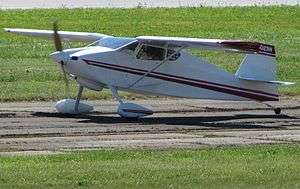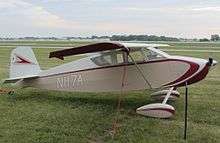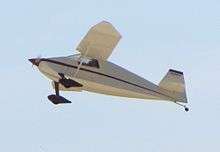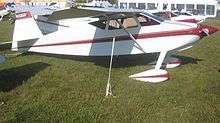Wittman Tailwind
| Wittman Tailwind | |
|---|---|
 | |
| Wittman W-10 Tailwind | |
| Role | light aircraft |
| Manufacturer | homebuilt |
| Designer | Steve Wittman |
| Number built | >350 |
| Unit cost |
approximately $2285 to build in 1971[1] |
The Wittman W-8 Tailwind is a popular two-seat light aircraft for homebuilding. It is a high-wing, braced cabin monoplane of taildragger configuration. It is constructed with a steel tubing fuselage, wood wings, and fabric covering. It offers exceptional cruising speeds and is economical to operate and maintain.[2]
Design and development
The Tailwind is the third in a series of high-wing aircraft designed by Sylvester J. "Steve" Wittman (1904–1995), a well-known air racing pilot and race plane designer, who also played an important role in the emergence of homebuilt aircraft with the Wittman Tailwind and other designs in the United States.[3] The first, the Wittman Buttercup two-seater, and later the Wittman Big X four-seater, which was bought by Cessna to use its spring steel landing gear. The Tailwind also inspired the last iteration, the O and O Special. A model of the 1965 Wittman Tailwind may be found in the Sun 'n Fun Museum http://www.sun-n-fun.org/Museum.aspx

Wittman developed the C-85 powered "Flying Carpet" in 1953, later renaming it to the "Tailwind".[4] In 1953, the Tailwind became the first aircraft covered under the FAA's Experimental category to be certified to carry a passenger. While crude looking by modern standards, it outperformed many similar factory-built planes, and only with the advent of composite construction were new designs able to achieve similar speed per horsepower and range.[5]
Steve Wittman and his wife were killed April 27, 1995 when their "O&O Special", a similar, larger and one-of-a-kind aircraft crashed. The propeller and some fabric covering from this "O&O Special" is on display in the Wittman hangar located on the Pioneer Airport, Oshkosh, Wisconsin. Aircraft Spruce & Specialty Co of Corona, California acquired the rights to the Tailwind in January 1996 and is currently the exclusive distributor for plans and materials.[6]
Variants

- W-8 Tailwind
- The W-8 (initial version) updated to a new designation, the W-10.
- Overton Tailwind - One example built with a 25ft constant taper wing with wood spar, foam and composite skin construction.[7]
- W-9 Tailwind
- The W-9L was introduced in 1958 with a constant speed propeller, 35 gallon fuel tank, and a tricycle landing gear.[8]



- W-10 Tailwind
- Tapered wingtips, Tricycle gear version options
- AJEP Tailwind
- Marketed in the UK by AJEP in the 1970s in both kit and ready-to-fly form.
Specifications (1953 W.8)
General characteristics
- Crew: one pilot
- Capacity: 1 passenger
- Length: 19 ft 3 in (5.87 m)
- Wingspan: 20 ft 11 in (6.38 m)
- Height: 5 ft 3 in (1.6 m)
- Wing area: 84 ft2 (7.8 m2)
- Empty weight: 685 lb (311 kg)
- Gross weight: 1,235 lb (560 kg)
- Powerplant: 1 × Continental C85, 85 hp (65 kW)
Performance
- Maximum speed: 200 mph ( km/h)
- Range: 600 miles (970 km)
- Service ceiling: 16,000 ft (4,900 m)
- Rate of climb: 900 ft/min (4.6 m/s)
See also
- Aircraft of comparable role, configuration and era
References
- ↑ Leo J. Kohn (Winter 1971). "The true cost of building your own plane". Air Trails: 63.
- ↑ Aircraft Spruce & Specialty
- ↑ http://www.totalracing.com
- ↑ Budd Davisson (August 2013). "15 Experimental Favorites". Sport Aviation: 74.
- ↑ Budd Davisson's Airbum.Com
- ↑ Aircraft Spruce & Specialty
- ↑ Jack Cox (September 1991). "Taperwing Tailwind". Sport Aviation.
- ↑ George Hardie, Jr. (November 1958). "Steve Wittman's New Tailwind". Sport Aviation.
- Taylor, Michael J. H. (1989). Jane's Encyclopedia of Aviation. London: Studio Editions. pp. 51, 897.
- Airventure Museum website
External links
| Wikimedia Commons has media related to Wittman Tailwind. |